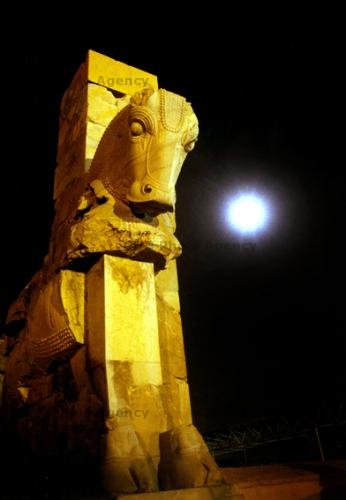We, the Undersigned wish to educate, and inform you of the history of Persian Gulf, and Oppose any name change attempts by any organization or government. Centuries ago, in the Latin American geography books the Persian Gulf has been referred to as More Persicum or the Sea of Pars (1). The Latin term "Sinus Persicus" is equivalent to "Persicher golf" in French, "Persico qof" in Italian, "Persidskizalir" in Russian and "Perusha Wan" that all mean "Pars" (2).
The Greek historian Herodotus repeatedly referred to the Red Sea as the "Arab Gulf" (3), and Straben, the Greek historian wrote: Arabs are living between the Arabian Gulf and the Persian Gulf (4). There are undeniable legal evidences and documents in confirmation of the genuineness of the term Persian Gulf. From 1507 to 1560 in all the agreements that Portuguese, Spanish, British, Dutch, French and Germans concluded with the Iranian government or in any other political event everywhere there is a mention of the name Persian Gulf (5).
The document for the independence of Kuwait signed on June 19, 1961 by Abdullah As-Salem As-Sabah refers to "Al-Khalij al-Farsi" in the Arabic texts and "Persian Gulf" in English texts, and has been registered in the Secretariat of the United Nations according to article 102 of the U.N. Charter and can be invoked at any U.N. office (6).
Since the beginning of the 20th century, the name "Persian Gulf" has been used in geography and history books with less reference to the "Fars Sea". Such a change has suggested the idea that the "Fars Sea" had been an old name substituted by a new term "Persian Gulf" (7) in 1930s efforts for changing the name of Persian Gulf was heightened when Sir Charles Bellgrave, the British diplomatic envoy in Iranian island of Mishmâhig, which today known as Bahrain opened a file for the change in the name of the Persian Gulf and proposed the issue to the British Foreign Office.
The United Nations with its 22 Arab member countries has on two occasions officially declared the unalterable name of the sea between Iran and the Arabian Peninsula as the Persian Gulf. The first announcement was made through the document UNAD, 311/Qen on March 5, 1971 and the second was UNLA 45.8.2 (C) on August 10, 1984. Moreover, the annual U.N. conference for coordination on the geographical names has emphatically repeated the name "Persian Gulf" each year (8).
Although using the "Arabian Gulf" instead of the "Persian Gulf" has no basis and will not be accepted in any culture or language, however, it will not diminish our responsibility in expressing the reality and eliminating ambiguities as the main and oldest inhabitants of the region.
Footnotes:
1- Institute of Political and International Studies, series of articles of seminar on Persian Gulf issues,
page 135
2- Institute for Political and International Studies, selected Persian Gulf documents, volume 1, page
18, Institute of Political and International Studies, series of articles of seminar on Persian Gulf issues,
page 136.
3- Institute of Political and International Studies, selected Persian Gulf documents, pages 18-22,
Institute of Political and International Studies, series of articles of seminar on Persian Gulf issues,
page 137. Seyed Hassan Mousavi "A brief discussion on historical-political geography of the Persian Gulf..." sociology and humanities of Shiraz University, page 118. Mehdi Azimi, "Persia Gulf Political History", Port and Sea, page 22.
4- Institute of Political and International Studies, selected Persian Gulf documents, volume 1, page 22.
5- Institute of Political and International Studies, series of articles of seminar on Persian Gulf issues, page 148.
6- Institute of Political and International Studies, ibid, page 149.
7- Pirouz Mojtahedzadeh, "Persian Gulf in return for history", political and economic, Nos. 105-106, page 26.
8- Pirouz Mojtahedzadeh, "Persian Gulf in return for history", Nos. 105-106, page 28
Sunday, January 27, 2008
Persian Gulf
Tuesday, January 15, 2008
The History of TERMEH
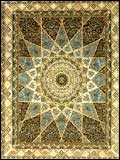
TERMEH is a nice cloth that is woven since SAFAVI era in IRAN and now Yazd province is the main center of producing it.
There is an argument between researchers about it's origin. Some of then believe that Termeh has been made in KASHMIR
and then brought to Iran. Others say that Iranian have been the innovator of weaving Termeh and this material has been
taken in to concentration like other handicrafts in other parts of the world.
(Kashmir: Historical region divided between India and Pakistan).
But it is the real fact that Iranian Termeh in comparison with what ever produced in Kashmir is much better and it has
different coloration and designs.
The only reason that made the Kashmir Termeh famous is using a kind of string which is produced by "Wild Goat's Wool".
Besides, the main place where it lives is Himalaya Mountains range, located North of India. So Kashmir Termeh weavers
have had more availability to it while Iranian had to use Fleece.
Weaving:
In the past, the first step in Termeh weaving was preparing it's raw materials. So it was very important to be careful
while preparing wool, washing and drying.
Weaving Termeh needs good wool which has tall fiber. Usually the designs of Iranian Termeh were the result of the
co-operation between main persons (an expert and a worker called "Goushvareh kesh"). Weaving Termeh was a very careful,
sensitive and time consuming work that a good weaver could produce only 25 to 30 centimeters in a day. The background
colors which are used in Termeh are Jujube Red, Light Red, Green, Orange, and Black.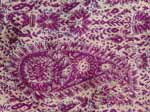
Termeh as a valuable cloth has many different usage. So it woven on different sizes and shapes such as:
1. 150*150 centimeters for table cloth and wrapper.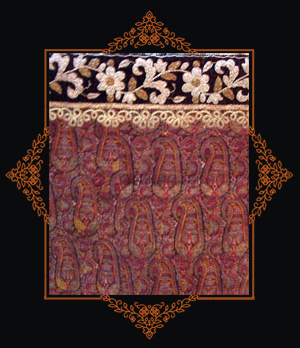
2. Checked pattern which is like Bee's Hive and is used for table cloth.
3. Striped pattern which is of two models: Narrow and Wide striped.
4. Atabaki pattern which was one of the Kashmiri's Termeh was used for expensive fabric because it was a finely women
Termeh.
5. Zomorrodi pattern in which the used green color more than the others.
6. "Kashmiri Shall" (Cashmere) in which the shape of Deer's Horn was used for it's design.
Termeh is a very durable cloth in which fixed colors are used so we can use any kinds of washer.
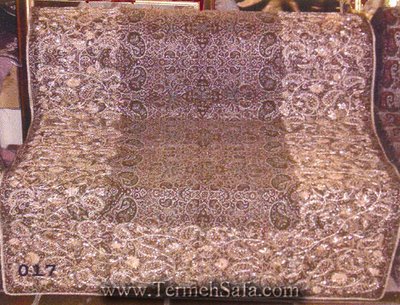
Source: Tourist Magazine
Thursday, January 10, 2008
Mehregan Celebration
.
MEHREGAN is one of the most Ancient Farina Festivals know dating back at least as far as the earliest Aryans (Iranians).
There are many accounts as to the beginning of Mehregan. A few, different versions are listed bellow:
1. Mehregan is a day of victory when angels helped "Feraydoun" and "Kaveh" become victorious over "Zahak".
They imprisoned him in the Damavand Mountain where he died from his wounds.
2. Mehregan is the day God gave light to the world that had previously been dark.
3. On this day "Mashya" and "Mashyaneh" (a concept of Semitic Adam and Eve) were created.
4. On this day the sun was created.
In some from or another, the feast day of Mehregan has always been honored for many thousands of years in IRAN.
MEHR is also the time of harvest, (same principles as thanks giving).
Some scholars believe that the month of Mehr was the beginning month of the calendar year during the Achaemenian era.
The Mehregan feast celebrated the beginning of a new year.
Mehr in Avestan is "Miora" and in Pahlavi "Mitr". In modern Farsi, it has become "Mehr".
Although it can be slightly confusing, it should be remembered the word "Mehr" has been used for God, an angel, a symbol of
the sun, as well as the seventh month of the Persian Calendar.
When the Indo-Europeans lived together, Mehr was considered one of the great Gods of that time.
The Ancient Iranians thought Mehr was responsible for Love and Friendship, Contracts and Convenants, and a Representation for light.
Later, Mehr was also considered as a symbol of the sun. There again,
Mehr was considered to be a God of heroism and warfare the Iranians soldiers were strong believers and had songs for Mehr.
With expansion of Achaemenian Empire, the worship of Mehr was taken to other countries.
Long ago, Mehregan was celebrated with the same magnificence and pageantry as Norouz. It was customary for people to send or give presents
that they personally liked themselves! Rich people usually gave gold and silver coins, heroes and warriors gave horses while others gave gifts
according to their ability, even an apple those fortunate enough, will help the poor with gifts.
After the Mongul invasion, the feast celebration of Mehregan lost its popularity. But Zoroastrians of Yazd, Kerman, and Shiraz continued to celebrate Mehregan.
- How to prepare for Mehregan:
The sides of the tablecloth are decorated with Marjoram. The Holy Book Avesta, a Mirror and Sorme Dan (Antimony Cellar)
are placed on the table together with Rose water, Sweets, Vegetables and Fruits, especially Pomegranates and Apples.
A few Silver Coins and Senjed Seeds (fruit of the lotus tree) are placed in dish of pleasant smelling wild Marjoram water. Almonds and Pistachio are also used.
A burner is also part of the table setting for Kondor (Frankincense) and Espand (Rue Seeds) to be thrown on the flames.
At lunch time when the ceremony begins, everyone in the family stands in front of the mirror to pray.
Sherbet is drunk and then as a good women, Sorme is rubbed around their eyes. Handfuls of wild Marjoram, Senjed Seeds and Noghl (Sugar Plum)
are thrown over each others heads while they embrace one another.
In some of the villages in Yazd, Zoroastrians still sacrifice sheep for Mehr. These sacrifices are done on the day of Mehregan and for three days afterwards.
The sacrifice should be done during the hours of sunlight.
The sheep is placed on three stones in the furnace, representing the "Good Words", "Good Deeds" and "Good Thoughts", and barbecued.
After this special ritual, the sheep, including the skin and fat is taken to the fire temple.
The fat is thrown on the fire to make the flames burn fiercely and then the participants pray.
To learn more about Iranian Festivities and Celebrations also see Norouz (New Year) and the Jashne Tirgan (Tirgan Celebration).
Source: Tourist Magazine
Friday, January 4, 2008
Shame on 300, the movie
Great Persians essay is an evidence that proves, the 300 is a BIG, BIG LIE against Empire of Persia, Xerxes the great and Persians as a whole.
Great Persians
IRAN, the only inheritor of PERSIA'S EMPIRE and territory of people with more than 7,000 years of great civilization; Now after this long period of time, it's still IRANIANS pride.
But in these prides, there are a lot of things that we have never heard of or we wrongly thought they were innovations of the WEST. Bellow are just a few of things about Persians Culture, Civilization, and Innovations:
1. The first humans that invented "Sewage System" were Persians.
2. Initial use of Metals Fuse in the world were by Persians in a city called "Silck" near the present KASHAN.
3. The first humans that invented "Coin" in order to trade and also started to Coinage of money were Persians.
4. The first World's "Cavalry Army" innovated by "Iranian Sam" with 115 soldiers.
5. The first Governmental Employment System was established by CYRUS the great and the employs and employees worked for 40 years; and after that, in retirement, they received
"Retirement Salary" and they became "Life Insured".
6. Cyrus the great originated a plan which according to that, all people in all territories were obliged to "learn Literacy free of charge". He was thought that the King can built and developed the country, just when people of that country have enough literacy and intelligence.
7. The Present Calendar (30 Days Month) was made by DARIUS command. He prepared a council with directionship of a Babylonian Scientist.
In the calendar of Ancient Persia, the first and fifteenth day of month were off and in general just 36 days were off during the year, 5 days for religious holiday and 31 days for Statutory holiday.
There were two important holidays, the first one was "Nouruz Holiday" (the new year celebration at the first of Spring) and the other one was "Death of SIAVASH".
8. Darius the great established World's first "Military Bases" and "Military Services" and according to that, all young men even the King and Minister's sons had to go to military and learned military skills in order to defend the PARS territory.
9. Darius the great established the World's first "Ministry of Roads and Transportation", "Ministry of Water", "Ministry of Development and Housing", and the "Ministry of Post"
in Persia probably 2,500 years ago.
10. Darius the great built the PERSEPOLIS Palace that was "World's Art Exhibition" and used 25,000 construction workers, working 10 hours in summer and 8 hours in winter.
The government gave one Gold coin to each architect every 5 days and also gave 250 grams Meat, Oil, Butter, Honey and Cheese to each worker's family in addition to their salary.

12. The Persians were the first humans that Tamed horses and gave to the World as a Gift.
13. As a matter of fact, Persians were the first people who trained some animals as Pet. Unfortunately some people have been thought that, it was the West's innovation.
According to a lot of proofs, the Persian Cat was the Ancient Persians favorite pet.
14. "Fire" was discovered by Persians.
15. The first humans who started Planting and Farming (Agriculture) were Persians.
16. Persians were the first humans who started to "Spin Wool" and invented "Thread".
17. The first people who started to print images and shapes on their clothes were Persians.
18. One of the Persians inventions that has startled everyone in every place of the world and also it's used by almost all people of world is "PANTS".
Yes it's right..."Pants" was invented by Persians with a little differences to contemporary "Pants". The first invented pants was loose in it's legs and became thin in toes.
19. The first people who used "Perfume" to became aromatic were Persians.
20. The first kind of "Alphabetic Letters" invented by Persians where lived in the South of Persia (North of the PERSIAN GULF) 7,000 years ago.
21. The first people who innovated "Glass" and used it to decorate their houses were Persians.
22. The first people who discovered "Coal" and used it's energy to do metal fusion or to warm their houses were Persians.
23. Persians were the first people who invented "Object Measurer" and started to scale Weigh, Distance and other things.
24. The "Earth Circularity" found out by "Aborayhan Birouni", one of the greatest Persian Astronomers and Scientists.
25. The World's first "Art and Industrial School" established by Cyrus the great in the "Shoosh", was to teach art and technical works to teenagers and youths.
26. Darius the great seized "Babylon" and after that freed 25,000 Jewish slaves that were enslaved and also were on the rack and tormented by the governor of Babylon.
Edited by Prof. Samin Roshani
